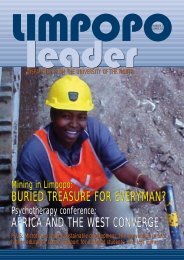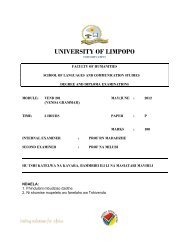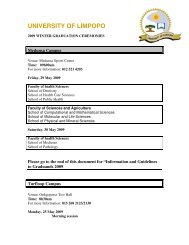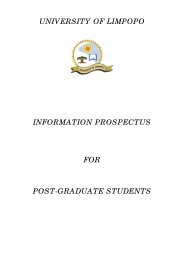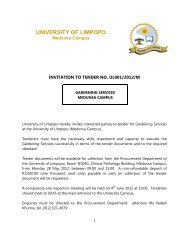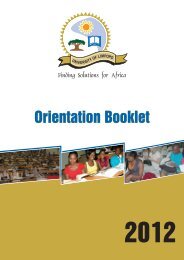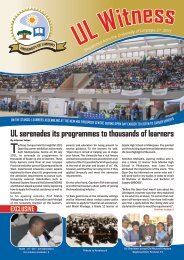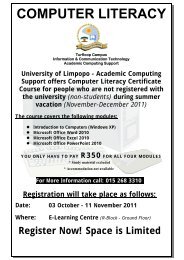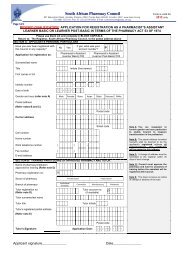Limpopo Leader - Spring 2005 - University of Limpopo
Limpopo Leader - Spring 2005 - University of Limpopo
Limpopo Leader - Spring 2005 - University of Limpopo
You also want an ePaper? Increase the reach of your titles
YUMPU automatically turns print PDFs into web optimized ePapers that Google loves.
Public Health:<br />
ONLINE POSTGRADUATE STUDIES<br />
FOR AFRICA<br />
mMEDUNSA’S NATIONAL<br />
SCHOOL OF PUBLIC HEALTH<br />
(NSPH) IS DEFINITELY AHEAD OF<br />
THE GAME. Established in 1998<br />
with an initial student intake <strong>of</strong><br />
42 postgraduate students, it’s<br />
produced more public health<br />
graduates since then than all<br />
other equitable institutions in<br />
South Africa put together.<br />
Current student numbers are in<br />
the region <strong>of</strong> 240, <strong>of</strong> which 142<br />
are Masters students and 11 are<br />
working towards their doctorates.<br />
The balance is doing postgraduate<br />
diplomas.<br />
‘A characteristic <strong>of</strong> our student<br />
body,’ says Dr Kebogile<br />
Mokwena, director <strong>of</strong> the NSPH,<br />
‘is that so many <strong>of</strong> them are from<br />
other African countries.<br />
Swaziland, Lesotho, Botswana<br />
and Namibia mostly, but also<br />
some from Zimbabwe and West<br />
Africa. Being a postgraduate<br />
school means that most <strong>of</strong> our<br />
students are already in jobs.<br />
What makes our reach so broad,<br />
in spite <strong>of</strong> this and in spite <strong>of</strong> the<br />
geographical spread <strong>of</strong> our<br />
students, is that we do distance<br />
learning – but it’s distance learning<br />
with a real difference.’<br />
The difference is that the NSPH<br />
uses a sophisticated Canadian<br />
model <strong>of</strong> computer-based learning.<br />
It’s called EMBANET; it costs in<br />
the region <strong>of</strong> R500 000 a year<br />
P A G E 2 4<br />
(but is based on the number <strong>of</strong><br />
student enrolments); ‘and it’s<br />
worth every penny – there’s no<br />
doubt about that’, adds Mokwena.<br />
She demonstrates the s<strong>of</strong>tware<br />
on the computer on her desk. The<br />
main menu comprises several<br />
special functions:<br />
• There’s an ordinary e-mail<br />
facility where students can<br />
communicate with other<br />
students or with lecturers, and<br />
vice versa.<br />
• There’s an NSPH library with<br />
online access to journals,<br />
books, research documents<br />
and other written material.<br />
• There’s a notice board available<br />
to all. On this is posted news<br />
<strong>of</strong> public health events (academic<br />
meetings, conferences, international<br />
gatherings), and also<br />
movements and availability <strong>of</strong><br />
lecturers and other in-school<br />
information.<br />
• Then there are the courses<br />
themselves. Three subheadings<br />
in this function are: About the<br />
Course which provides a<br />
summary <strong>of</strong> requirements,<br />
objectives and content; News<br />
Flash which contains relevant<br />
subsidiary material that might<br />
become available during the<br />
course, such as printed articles<br />
and upcoming television<br />
programmes; and finally the<br />
Course Material, which is<br />
divided into units, each focusing<br />
on a theme and dealt with in<br />
several lessons. (The course<br />
material has been developed<br />
and written at Medunsa.)<br />
• All submissions <strong>of</strong> course work<br />
are made and assessed<br />
electronically via a device<br />
called the ‘white board’ or<br />
virtual lecture room. Essays<br />
and tests by individual students,<br />
as well as comments from the<br />
responsible lecturer, are posted<br />
here where access is given to<br />
other students in the group.<br />
This interactive process, which<br />
frequently includes group<br />
discussions via a customised<br />
chat room, enriches the<br />
teaching/learning process.<br />
• A pre-designed course<br />
schedule provides details <strong>of</strong><br />
course timelines and due dates<br />
for assignments and gives an<br />
accurate picture <strong>of</strong> the time<br />
given to complete each<br />
element <strong>of</strong> the course. In<br />
addition, details <strong>of</strong> how<br />
students are to be evaluated<br />
and marked are provided.<br />
‘As you can imagine, it’s a<br />
teaching-intensive method,’ says<br />
Mokwena. ‘But for this reason,<br />
dropout rates are low. Even<br />
though it’s not easy to replace the<br />
potential for human interaction<br />
that can be got in an actual



